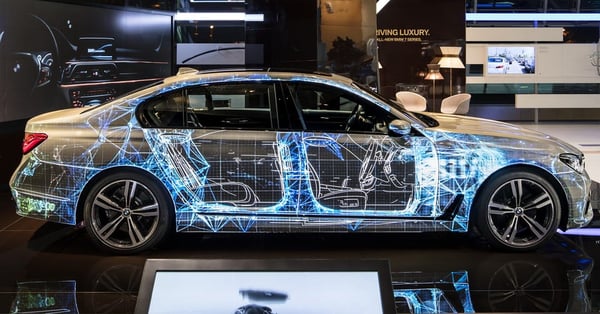Flexing on Instagram, personalising products and doing your bit for charitable causes. Loads of trends have driven experiential marketing thanks to technology. With budgets for this technique higher than ever and brands trying to outdo each other with more memorable campaigns, the need for experiential marketing technology is crucial.
 Image Credit: Lumen Magazine
Image Credit: Lumen Magazine
Here’s how it’s helped experiential marketing evolve.
- Surprise Consumers With Projection Mapping
- Switch It Up With Voice Activation
- Augmented Reality, Virtual Reality or Even a Hybrid
- Brands Are Watching You...
Surprise Consumers With Projection Mapping
Buildings and objects are the perfect canvas for video projections. People love being transported into a different world when technology manipulates and projects imagery on huge buildings and landscapes.
Don’t worry. You don’t always need a massive building to pull it off. Walls, floors, ceilings, the human body - you can now pretty much project onto anything. Just take a look at this effort from HP for its 17th installation at the 2017 Coachella music festival.
The campaign included projectors which filled a dome with bright, crisp visuals. There were also some subwoofers which provided bone-rattling spatialised audio which the audience felt. Their reaction just says it all…
Then there’s what BMW put together for its new 7 Series Sedan. Using aesthetic lighting installations and innovative storytelling, BMW utilised projection mapping to highlight the development process and engineering expertise behind the latest release.
Don’t just take our word for it. See the digital transformation yourself below.
By using this technology, BMW found the perfect combination of digital luxury storytelling and strong aesthetic appeal which fits the 7 Series perfectly.
Switch It Up With Voice Activation
Look how the likes of Siri and Alexa have dominated technology recently. It’s so easy to start playing music at home or turn the lights off - so why not use this tech in an experiential marketing campaign?
Just don’t do what Burger King did by taking advantage of Google Home’s voice activation feature. Eventually, Google blocked it and shut it down. You don’t want that.
Sometimes, the simplest activations leave the biggest impact. Just look at Coca-Cola. They’ll obviously have millions in the bank for marketing purposes, but their voice-activated dispenser is one that went down a treat.
In fact, it was the brand’s first-ever use of voice recognition technology and probably won’t be the last.
For a limited time, a panel encouraged passersby to say ‘yes’ into a microphone. When triggered, it dispensed a chilled bottle of Coke Sugar-Free. It’s perfect - it attracted consumer interest who loved the fact that they needed no human interaction to get the ice-cold drink.
Now if only I could buy a 12-pack of Krispy Kreme doughnuts for myself with no human interaction so a supermarket worker doesn’t judge me.
Augmented Reality, Virtual Reality or Even a Hybrid
These aren’t just buzzwords anymore. You can use AR or VR (or why not both?) to blend digital elements with real-world events. This technology now lets brands bring experiences to life and create campaigns at scale.
Whether it’s using a mobile app to reveal an object or wearing a massive headset to explore a 3D environment, this technology is taking the world - not just experiential marketing - by storm. It increases interaction by exposure and promotion through word of mouth. It can be personalised and the blend of digital and live experiences lives long in the memory.
Here are some examples of big brands that have already adopted this technology in their experiential marketing efforts.
- Eminem’s Coachella performance adopted AR by launching an app.
- Pet food brand Felix projected a cat onto a screen which interacted with commuters.
- Mirage launched ‘drinkable tech’ with an AR app which was a hit on Instagram.
- Coca-Cola let players feel like they played alongside football stars through AR and other impactful effects.
Brands Are Watching You…
Not to sound creepy but brands also utilise facial recognition technology if you want to go one step further to really immerse guests. This takes experiential marketing to a whole new level because it’s probably the last thing consumers expect (although they probably don’t want to know they’re being watched).
Mazda did it nicely in Toronto with a billboard at the Royal Bank Plaza. Using a combination of crowd detection and facial recognition software, it allowed the billboard to detect each time passersby turned to look at the car by identifying when someone was in the vicinity of the ad. Just in case you were wondering, 15,000 heads turned to look at it.
Then there’s DiGiorno, the pizza brand. It used facial recognition and even emotion tracking software to measure consumer reaction to pizza. They found that guests’ moods improved when pizza was taken out of the oven and their attitudes improve when they smelt the pizza being baked. The verdict? People love pizza.
There’s always going to be new technology on the horizon which will change the way brands deliver experiential marketing campaigns. However, knowing how technology has changed this marketing technique and actually delivering successful campaigns are two different things.
That’s why we’ve created the ultimate experiential marketing playbook to help you out.
Get the Experiential Marketing Playbook
This guide is full of all the necessary info you need from the benefits, tips on running your campaign, examples you can take inspiration from and loads more. To get your hands on this free playbook and show your competition how it’s done, click on the link below to get your copy.

